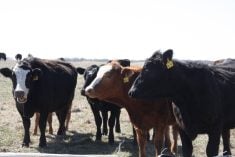This cattle market information is selected from the weekly report from Canfax, a division of the Canadian Cattlemen’s Association. More market information, analysis and statistics are available by becoming a Canfax subscriber by calling 403-275-5110 or at www.canfax.ca.
US interest on fats
Alberta fed cattle prices have been at a premium to the United States for 14 consecutive weeks, but some American buyer interest picked up during the past week. More than 36,400 fed cattle have headed south so far, but this is down 13 percent from the previous year.
Read Also

Defence investments could benefit agriculture
A bump in Canada’s NATO spending commitments could lead to infrastructure investments that would benefit rural areas
At prices comparable with western Canadian packer bids-sales, U.S. packer bids were reported from US$215-$216 per hundredweight, working back to the mid $160s on a live basis f.o.b. the feedlot.
Flat bids with no weight breaks were being negotiated with western Canadian packers because some producers were indicating a small percentage of their cattle would have carcass weights of more than 1,000 pounds. Packers were willing to bid with no weight breaks, but there has been a few times where discounts for cattle older than 30 months have increased.
Domestic slaughter is up seven percent over last year this time with about 348,000 head processed. Domestic beef production is also up seven percent. Total cattle sold on a carcass basis was 85 percent of the total kill. Average dressing percentage was 60 percent, and more than 68 percent graded AAA.
Slaughter cows trending up
Slaughter cow prices were slightly higher this week and good demand was observed on a moderate offering.
Dressed bids firmed to around C$175-$180 per cwt. delivered, while butcher bulls averaged $102.22 per cwt. Butcher bulls were up $2 to average $102.22 per cwt.
Last week, D1,2 cows in Alberta traded at $82-$95 per cwt. for an average of $88 per cwt. Ontario cows were $68-$79.45 per cwt. to average $74.20.
Western Canadian non-fed slaughter for the week ending March 3 was 18 percent larger than the previous week at 8,508 head. Spring demand is expected to be good.
Canadian non-fed exports to the U.S. as of Feb. 24 was slightly more than 2,340 head, which is down 44 percent from last year.
Feeders steady
Alberta feeder prices were mixed with steers trading mostly steady, while heifer prices fell back by $2.
Steer calves weighing more than 400 pounds saw good demand and prices traded steady to stronger. Average Alberta price for 400-500 lb. steers was $251 per cwt. Heifers were trading at $205-$226 per cwt. to average $215.
Large feeders over 800 lb. declined $1-$3 lower.
Steers in the 800-900 lb. range were $171-$186 per cwt. to average $177.69. Heifers in this category traded $157-$169 per cwt. to average $162.11
Weekly auction volumes rebounded by 12 percent following the February cold snap. About 43,400 head were sold. Year to date auction volumes are 14 percent lower, totalling 240,083 head.
Feeder exports to the U.S. as of Feb. 24 have been steady. Slightly more than 4,000 head went state-side and are 55 percent higher than last year this time at 20,341 head. However, live exports have been declining for the last few years and total exports for all classes of cattle are down 14 percent.
Trade has been active in the United States, and slaughter volumes are up for cattle and hogs. Total red meat production is up three percent from last year.
Dressed weights for beef ranged from US$203-$205 per cwt.
Exports of beef and pork are also setting records and were up 14.5 percent and 5.4 percent, respectively, compared to last year.














